Spinal Injuries M. Jamous M.D. Spinal Injuries Incidence

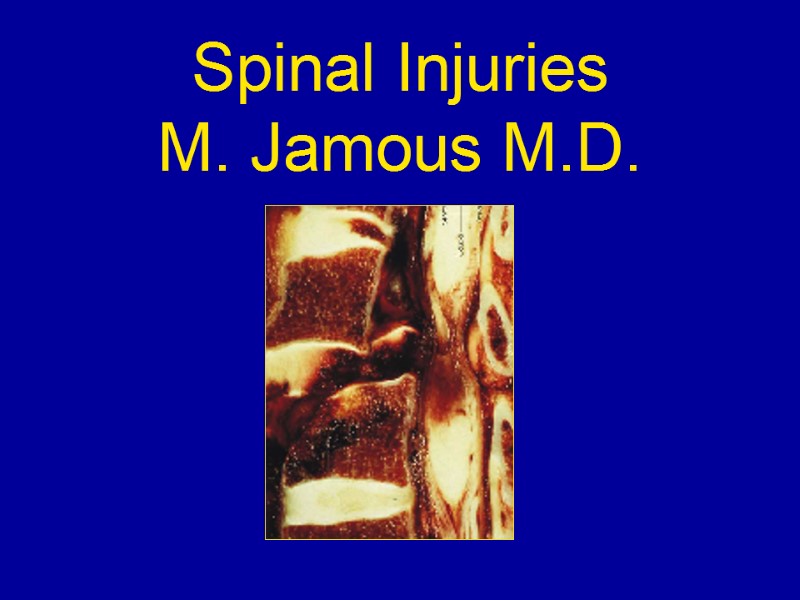
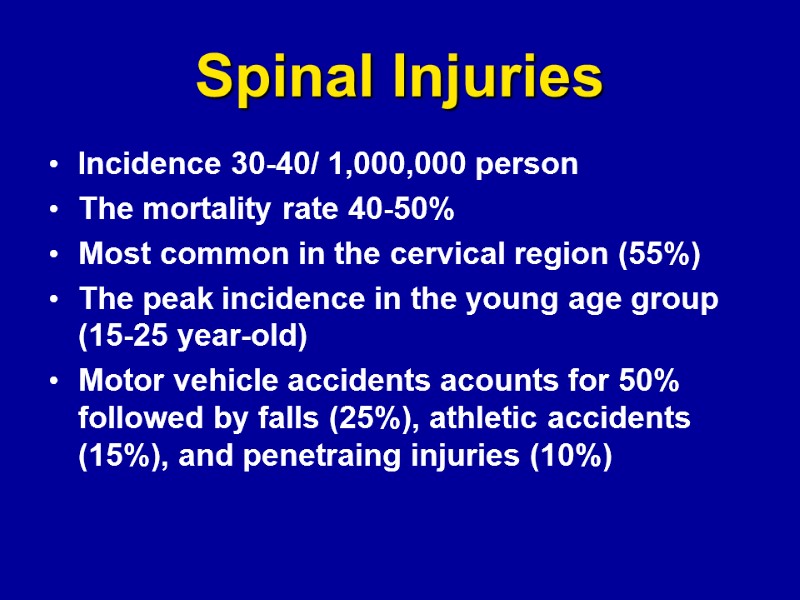

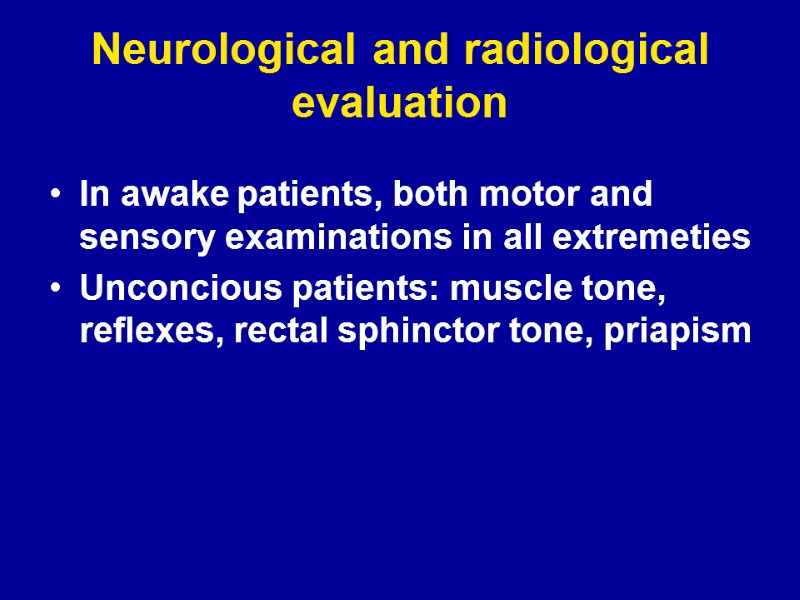
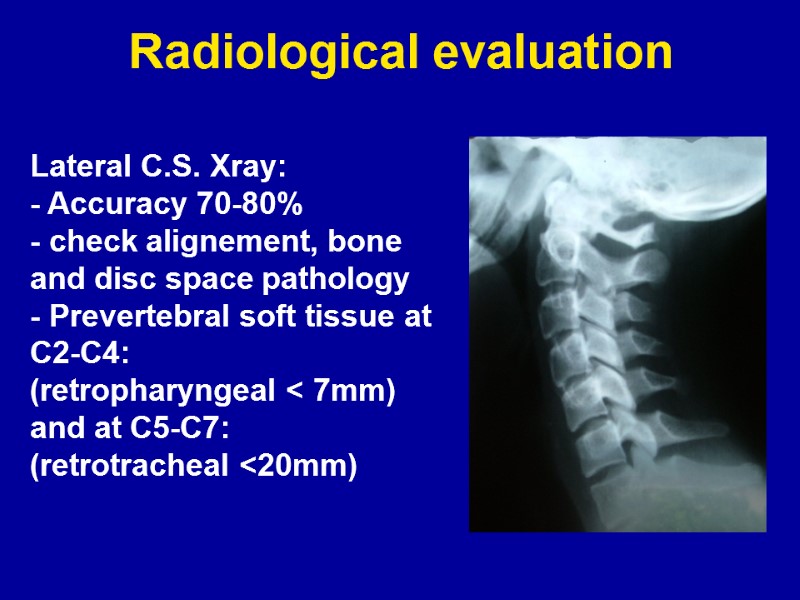
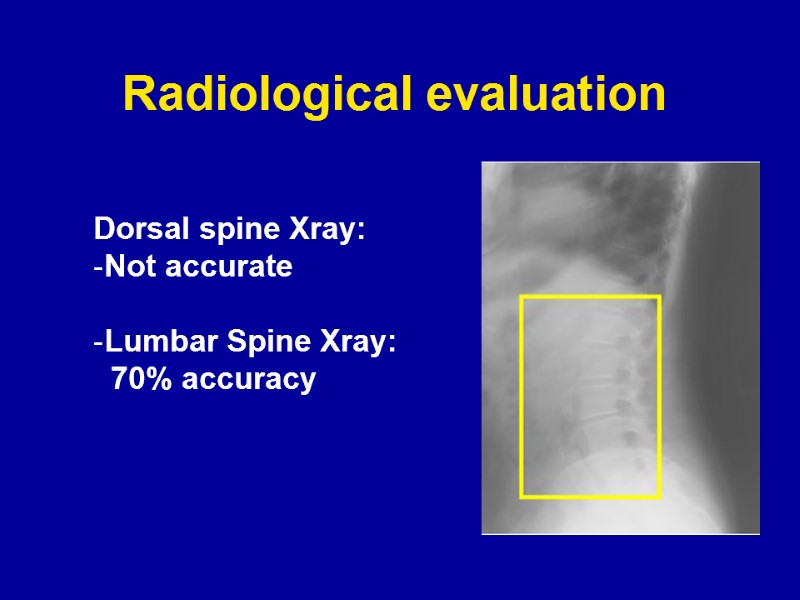
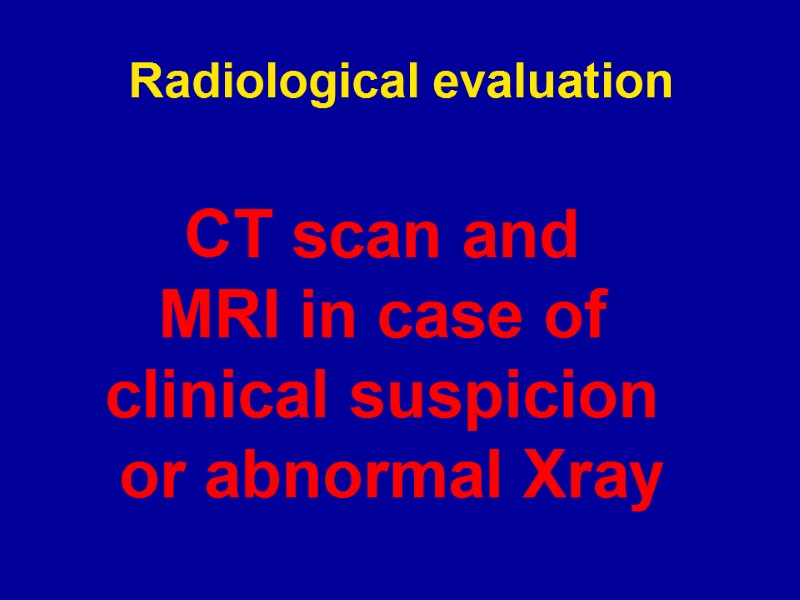
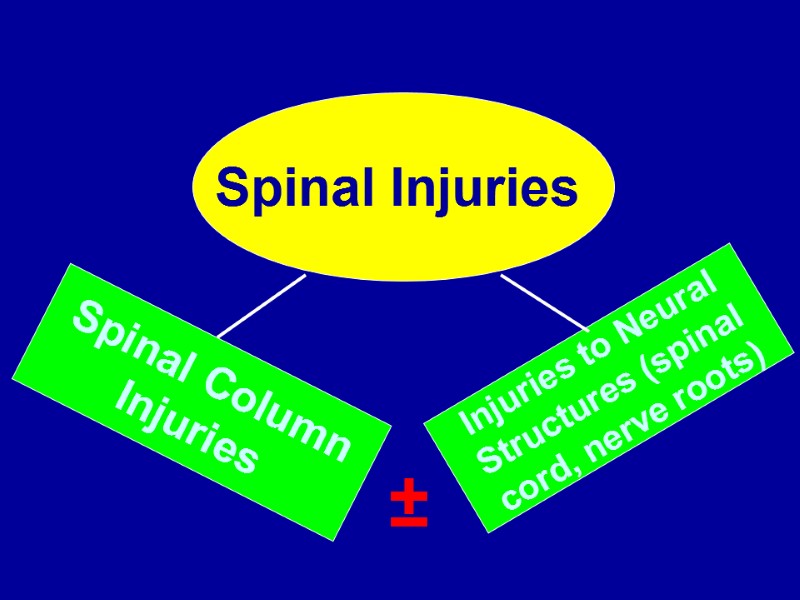
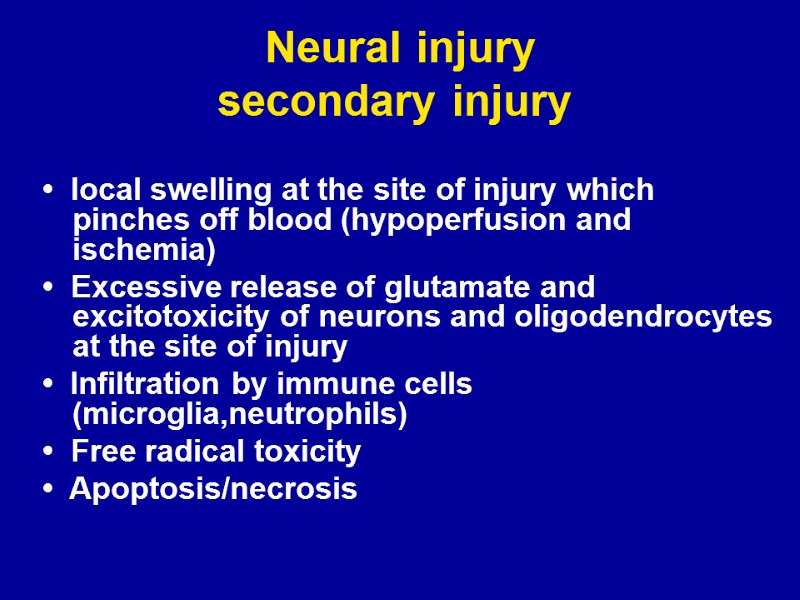
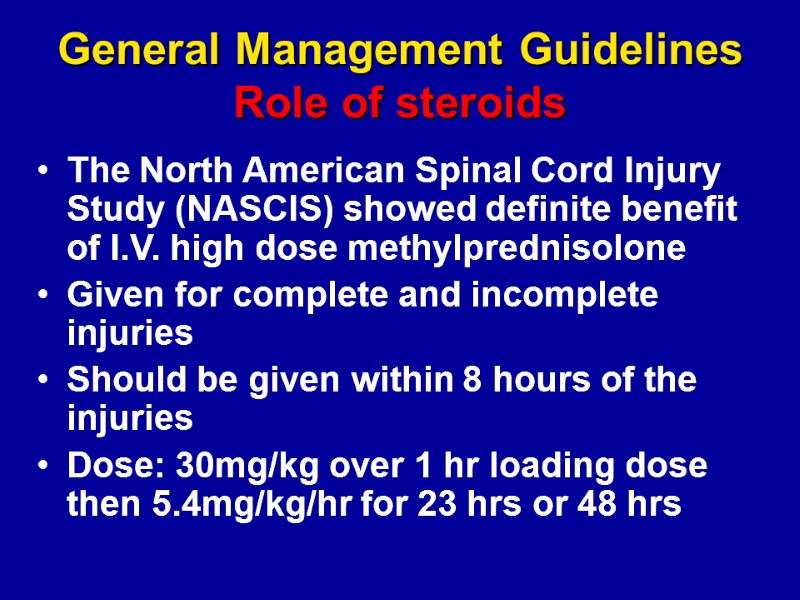
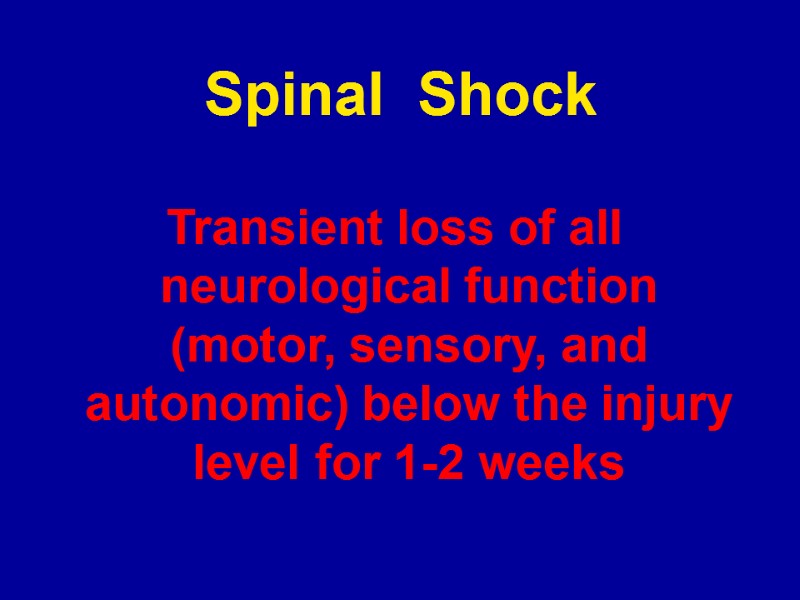
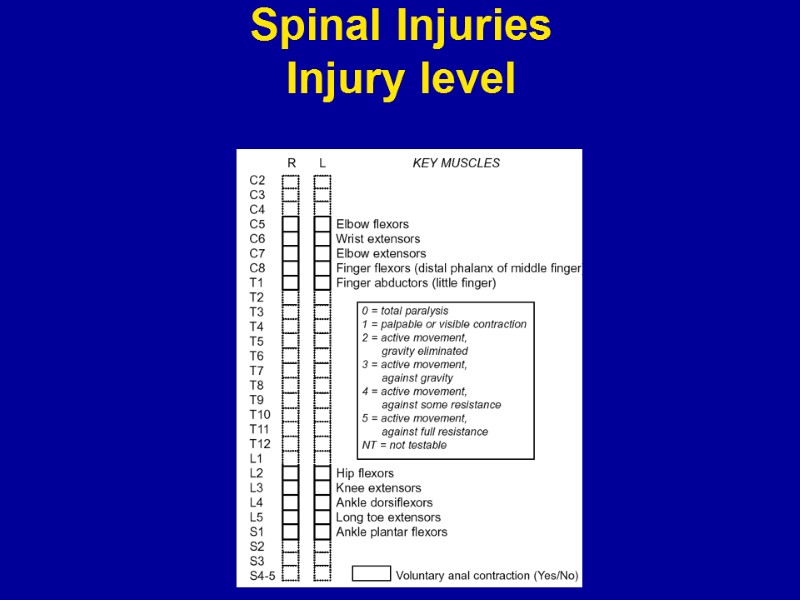

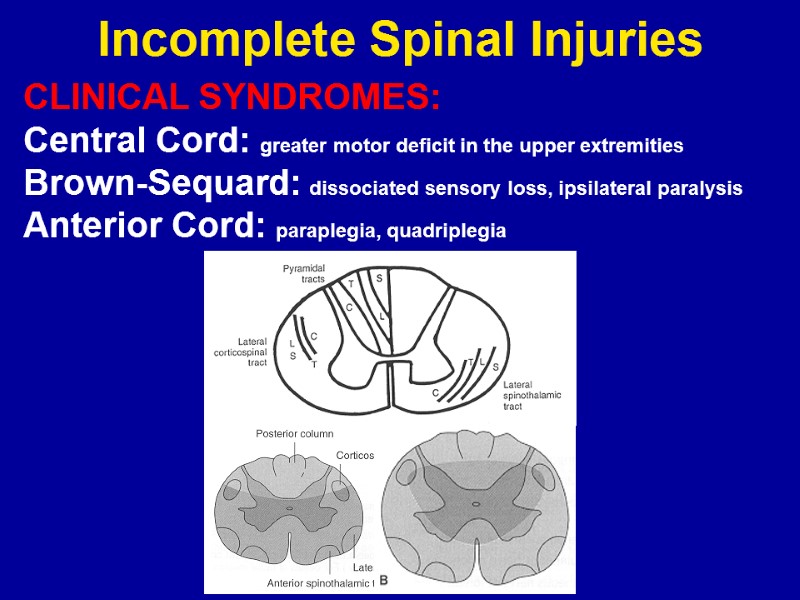
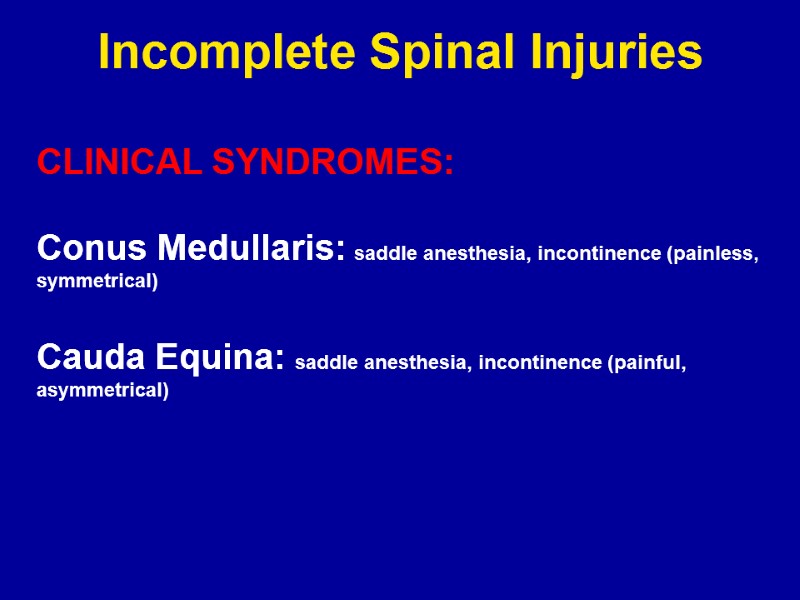
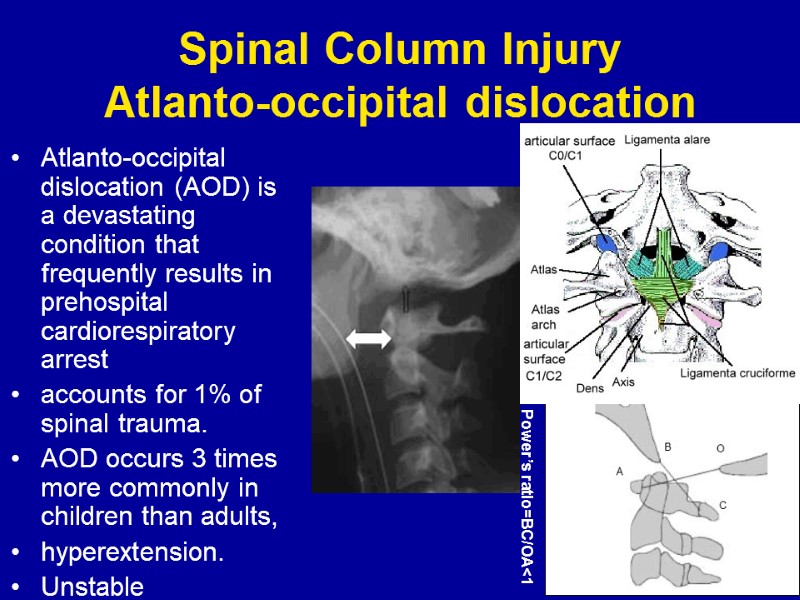
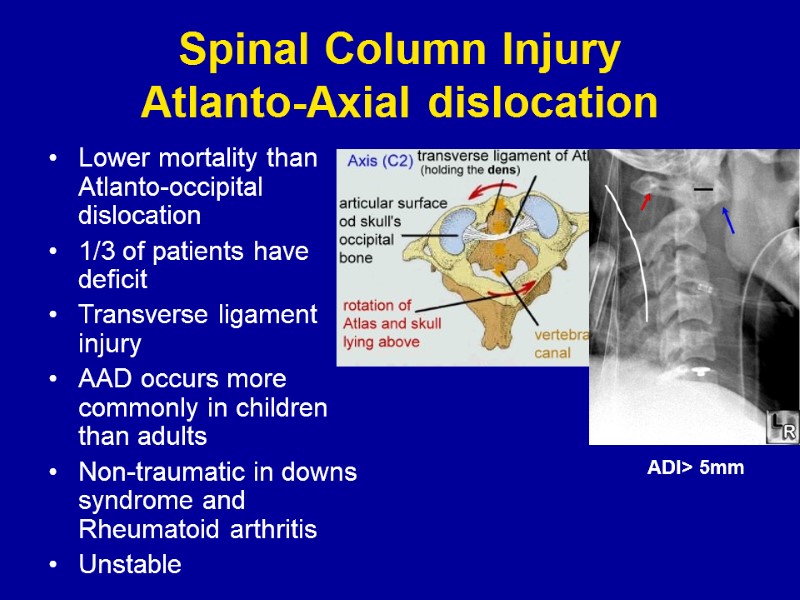
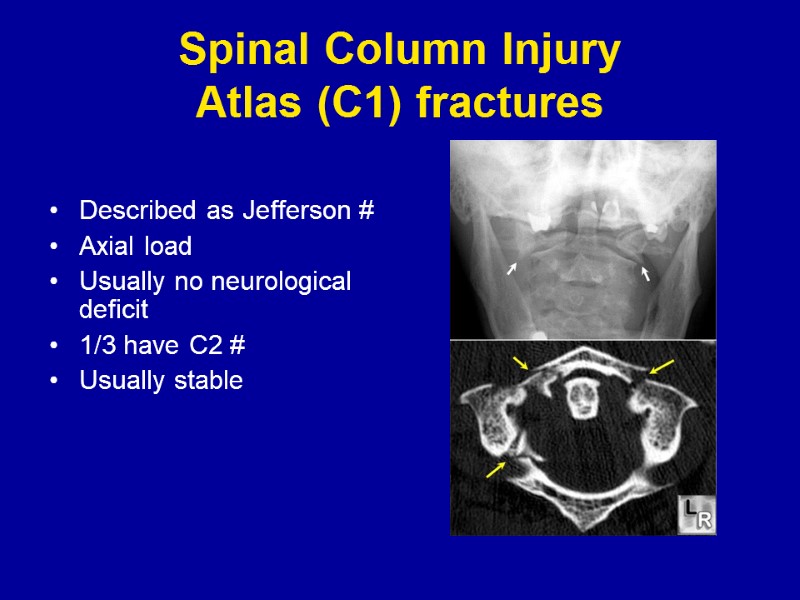
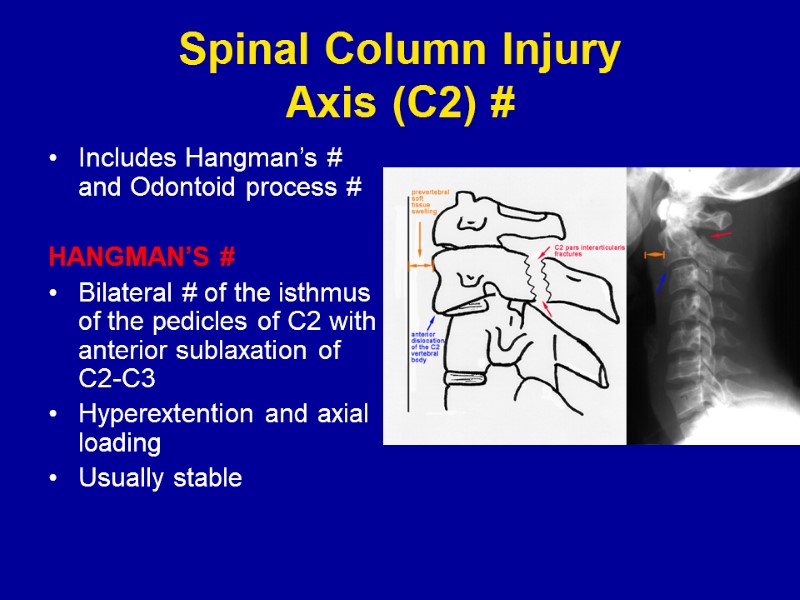
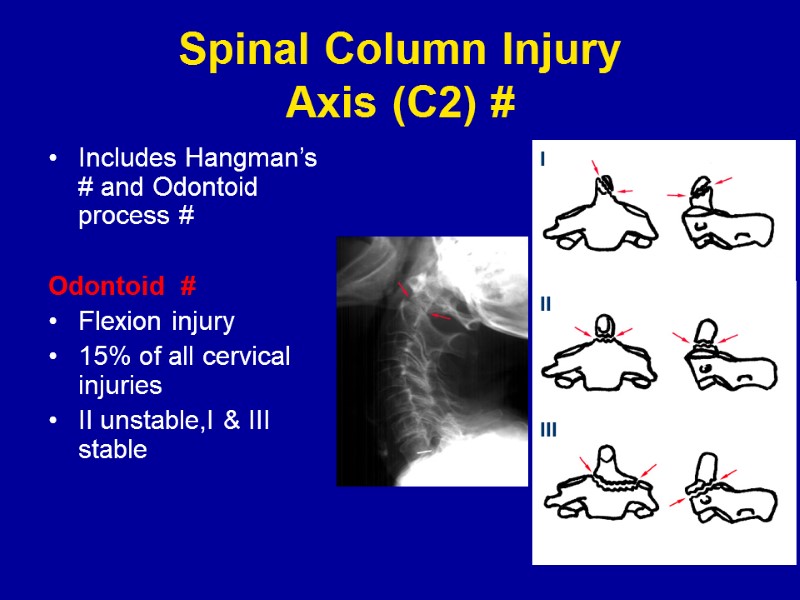
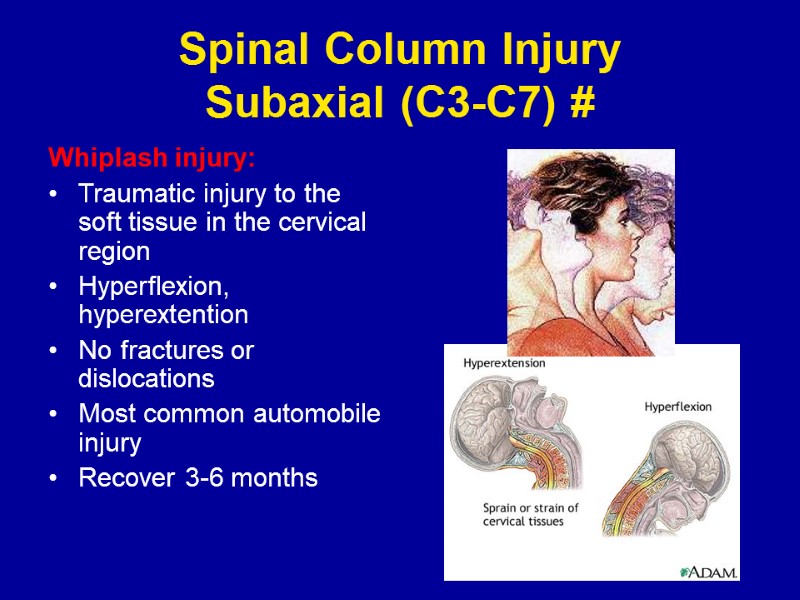
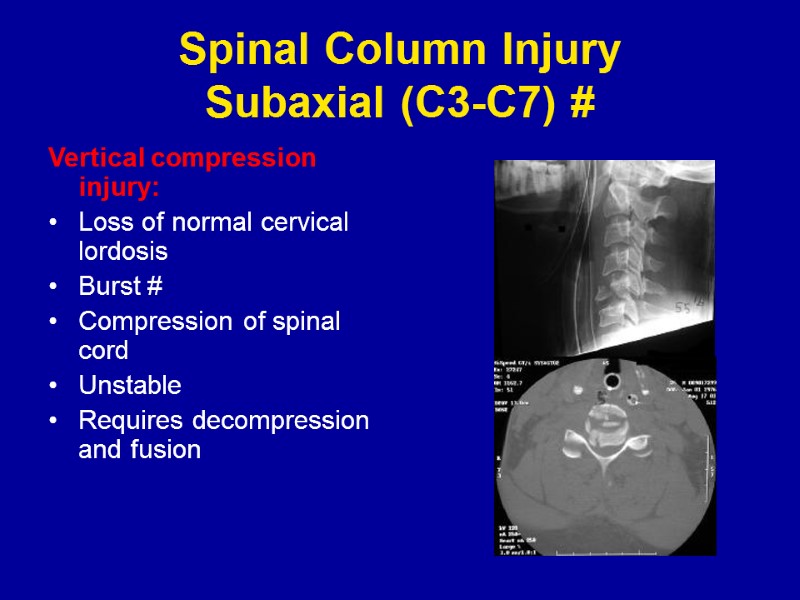
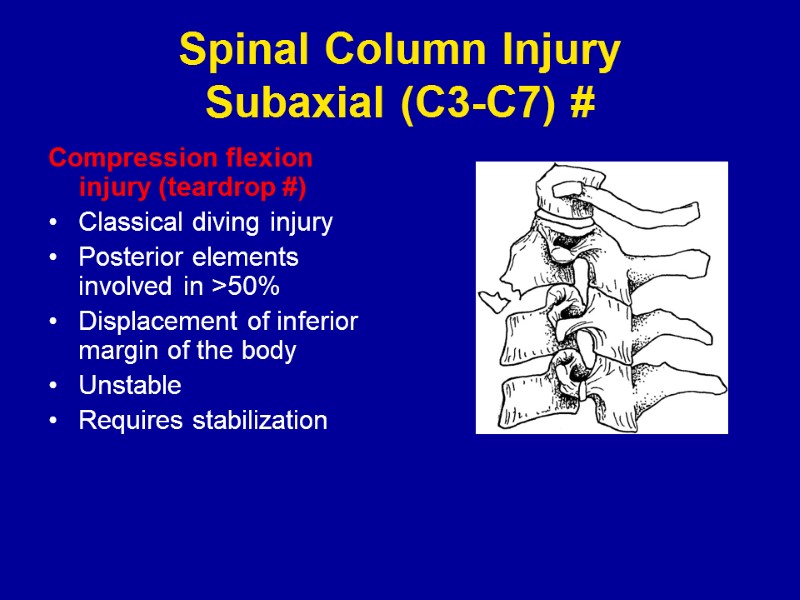
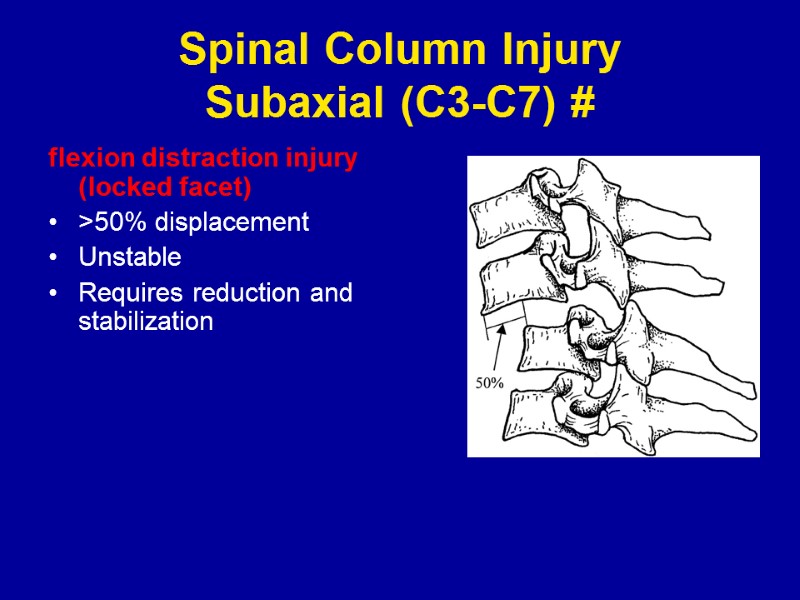
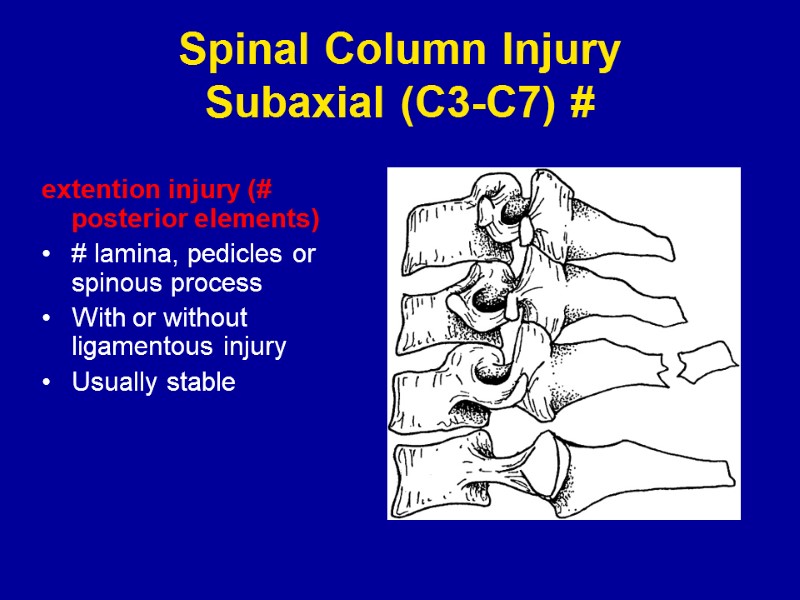
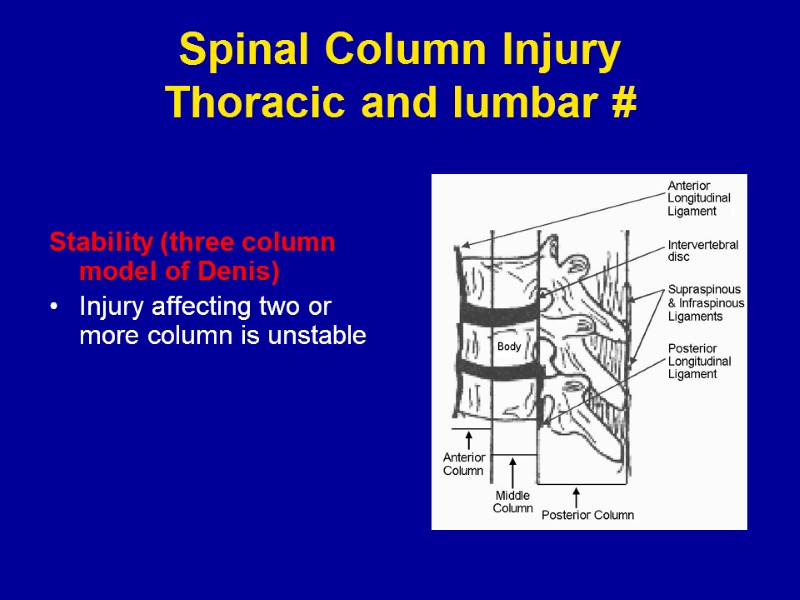

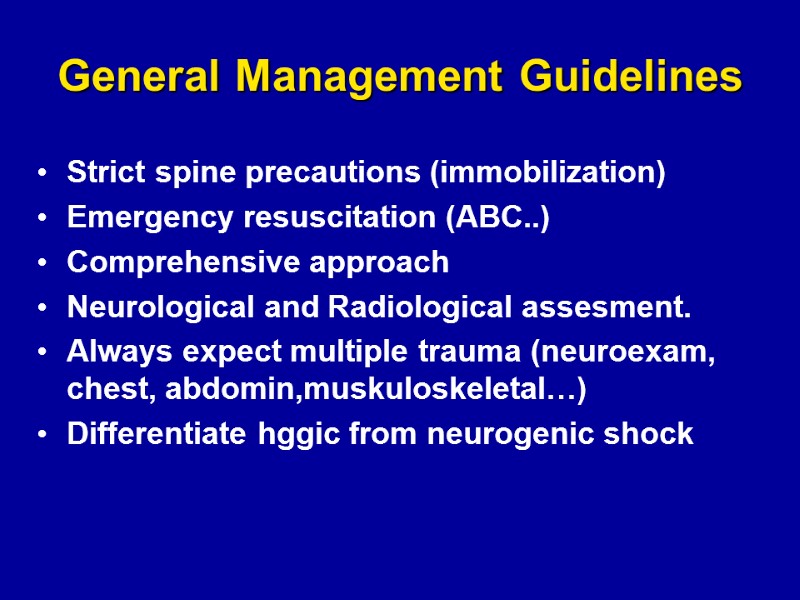
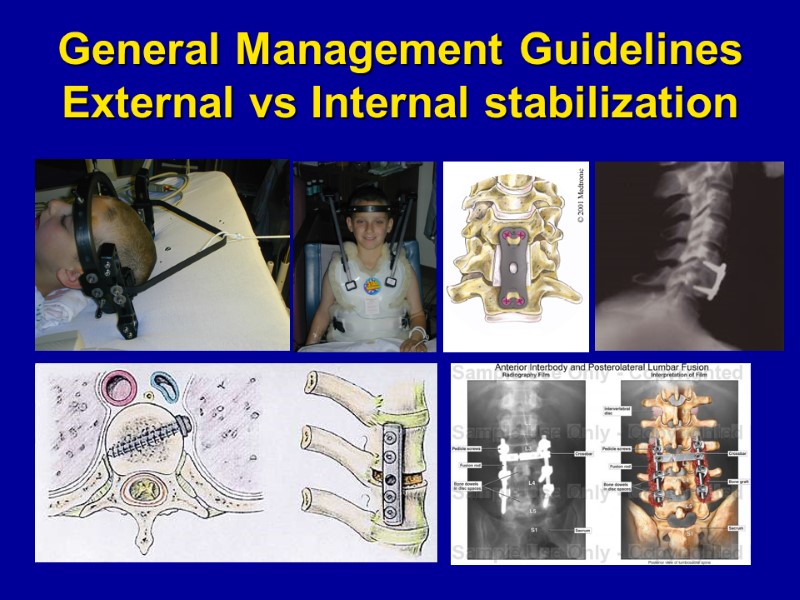
6804-spinal_injuries.ppt
- Количество слайдов: 29
 Spinal Injuries M. Jamous M.D.
Spinal Injuries M. Jamous M.D.
 Spinal Injuries Incidence 30-40/ 1,000,000 person The mortality rate 40-50% Most common in the cervical region (55%) The peak incidence in the young age group (15-25 year-old) Motor vehicle accidents acounts for 50% followed by falls (25%), athletic accidents (15%), and penetraing injuries (10%)
Spinal Injuries Incidence 30-40/ 1,000,000 person The mortality rate 40-50% Most common in the cervical region (55%) The peak incidence in the young age group (15-25 year-old) Motor vehicle accidents acounts for 50% followed by falls (25%), athletic accidents (15%), and penetraing injuries (10%)
 Acute evaluation and ER management Strict spine precautions (immobilization) Emergency resuscitation (ABC..) Comprehensive approach Always expect multiple trauma (neuroexam, chest, abdomin,muskuloskeletal…) Differentiate hggic from neurogenic shock
Acute evaluation and ER management Strict spine precautions (immobilization) Emergency resuscitation (ABC..) Comprehensive approach Always expect multiple trauma (neuroexam, chest, abdomin,muskuloskeletal…) Differentiate hggic from neurogenic shock
 Neurological and radiological evaluation In awake patients, both motor and sensory examinations in all extremeties Unconcious patients: muscle tone, reflexes, rectal sphinctor tone, priapism
Neurological and radiological evaluation In awake patients, both motor and sensory examinations in all extremeties Unconcious patients: muscle tone, reflexes, rectal sphinctor tone, priapism
 Radiological evaluation Lateral C.S. Xray: - Accuracy 70-80% - check alignement, bone and disc space pathology - Prevertebral soft tissue at C2-C4: (retropharyngeal < 7mm) and at C5-C7: (retrotracheal <20mm)
Radiological evaluation Lateral C.S. Xray: - Accuracy 70-80% - check alignement, bone and disc space pathology - Prevertebral soft tissue at C2-C4: (retropharyngeal < 7mm) and at C5-C7: (retrotracheal <20mm)
 Radiological evaluation Dorsal spine Xray: Not accurate Lumbar Spine Xray: 70% accuracy
Radiological evaluation Dorsal spine Xray: Not accurate Lumbar Spine Xray: 70% accuracy
 Radiological evaluation CT scan and MRI in case of clinical suspicion or abnormal Xray
Radiological evaluation CT scan and MRI in case of clinical suspicion or abnormal Xray
 Spinal Injuries Spinal Column Injuries Injuries to Neural Structures (spinal cord, nerve roots) ±
Spinal Injuries Spinal Column Injuries Injuries to Neural Structures (spinal cord, nerve roots) ±
 Neural injury secondary injury • local swelling at the site of injury which pinches off blood (hypoperfusion and ischemia) • Excessive release of glutamate and excitotoxicity of neurons and oligodendrocytes at the site of injury • Infiltration by immune cells (microglia,neutrophils) • Free radical toxicity • Apoptosis/necrosis
Neural injury secondary injury • local swelling at the site of injury which pinches off blood (hypoperfusion and ischemia) • Excessive release of glutamate and excitotoxicity of neurons and oligodendrocytes at the site of injury • Infiltration by immune cells (microglia,neutrophils) • Free radical toxicity • Apoptosis/necrosis
 General Management Guidelines Role of steroids The North American Spinal Cord Injury Study (NASCIS) showed definite benefit of I.V. high dose methylprednisolone Given for complete and incomplete injuries Should be given within 8 hours of the injuries Dose: 30mg/kg over 1 hr loading dose then 5.4mg/kg/hr for 23 hrs or 48 hrs
General Management Guidelines Role of steroids The North American Spinal Cord Injury Study (NASCIS) showed definite benefit of I.V. high dose methylprednisolone Given for complete and incomplete injuries Should be given within 8 hours of the injuries Dose: 30mg/kg over 1 hr loading dose then 5.4mg/kg/hr for 23 hrs or 48 hrs
 Spinal Shock Transient loss of all neurological function (motor, sensory, and autonomic) below the injury level for 1-2 weeks
Spinal Shock Transient loss of all neurological function (motor, sensory, and autonomic) below the injury level for 1-2 weeks
 Spinal Injuries Injury level
Spinal Injuries Injury level
 Spinal Injuries ASIA IMPAIRMENT SCALE: A =Complete: No motor or sensory function is preserved B =Incomplete: Sensory but not motor function is preserved C =Incomplete: Non-useful motor function is pre-served below the neurological level D =Incomplete: Useful motor function is pre-served below the neurological level E =Normal: Motor and sensory func-tionare normal.
Spinal Injuries ASIA IMPAIRMENT SCALE: A =Complete: No motor or sensory function is preserved B =Incomplete: Sensory but not motor function is preserved C =Incomplete: Non-useful motor function is pre-served below the neurological level D =Incomplete: Useful motor function is pre-served below the neurological level E =Normal: Motor and sensory func-tionare normal.
 Incomplete Spinal Injuries CLINICAL SYNDROMES: Central Cord: greater motor deficit in the upper extremities Brown-Sequard: dissociated sensory loss, ipsilateral paralysis Anterior Cord: paraplegia, quadriplegia
Incomplete Spinal Injuries CLINICAL SYNDROMES: Central Cord: greater motor deficit in the upper extremities Brown-Sequard: dissociated sensory loss, ipsilateral paralysis Anterior Cord: paraplegia, quadriplegia
 Incomplete Spinal Injuries CLINICAL SYNDROMES: Conus Medullaris: saddle anesthesia, incontinence (painless, symmetrical) Cauda Equina: saddle anesthesia, incontinence (painful, asymmetrical)
Incomplete Spinal Injuries CLINICAL SYNDROMES: Conus Medullaris: saddle anesthesia, incontinence (painless, symmetrical) Cauda Equina: saddle anesthesia, incontinence (painful, asymmetrical)
 Spinal Column Injury Atlanto-occipital dislocation Atlanto-occipital dislocation (AOD) is a devastating condition that frequently results in prehospital cardiorespiratory arrest accounts for 1% of spinal trauma. AOD occurs 3 times more commonly in children than adults, hyperextension. Unstable Power’s ratio=BC/OA<1
Spinal Column Injury Atlanto-occipital dislocation Atlanto-occipital dislocation (AOD) is a devastating condition that frequently results in prehospital cardiorespiratory arrest accounts for 1% of spinal trauma. AOD occurs 3 times more commonly in children than adults, hyperextension. Unstable Power’s ratio=BC/OA<1
 Spinal Column Injury Atlanto-Axial dislocation Lower mortality than Atlanto-occipital dislocation 1/3 of patients have deficit Transverse ligament injury AAD occurs more commonly in children than adults Non-traumatic in downs syndrome and Rheumatoid arthritis Unstable ADI> 5mm
Spinal Column Injury Atlanto-Axial dislocation Lower mortality than Atlanto-occipital dislocation 1/3 of patients have deficit Transverse ligament injury AAD occurs more commonly in children than adults Non-traumatic in downs syndrome and Rheumatoid arthritis Unstable ADI> 5mm
 Spinal Column Injury Atlas (C1) fractures Described as Jefferson # Axial load Usually no neurological deficit 1/3 have C2 # Usually stable
Spinal Column Injury Atlas (C1) fractures Described as Jefferson # Axial load Usually no neurological deficit 1/3 have C2 # Usually stable
 Spinal Column Injury Axis (C2) # Includes Hangman’s # and Odontoid process # HANGMAN’S # Bilateral # of the isthmus of the pedicles of C2 with anterior sublaxation of C2-C3 Hyperextention and axial loading Usually stable
Spinal Column Injury Axis (C2) # Includes Hangman’s # and Odontoid process # HANGMAN’S # Bilateral # of the isthmus of the pedicles of C2 with anterior sublaxation of C2-C3 Hyperextention and axial loading Usually stable
 Spinal Column Injury Axis (C2) # Includes Hangman’s # and Odontoid process # Odontoid # Flexion injury 15% of all cervical injuries II unstable,I & III stable I II III
Spinal Column Injury Axis (C2) # Includes Hangman’s # and Odontoid process # Odontoid # Flexion injury 15% of all cervical injuries II unstable,I & III stable I II III
 Spinal Column Injury Subaxial (C3-C7) # Whiplash injury: Traumatic injury to the soft tissue in the cervical region Hyperflexion, hyperextention No fractures or dislocations Most common automobile injury Recover 3-6 months
Spinal Column Injury Subaxial (C3-C7) # Whiplash injury: Traumatic injury to the soft tissue in the cervical region Hyperflexion, hyperextention No fractures or dislocations Most common automobile injury Recover 3-6 months
 Spinal Column Injury Subaxial (C3-C7) # Vertical compression injury: Loss of normal cervical lordosis Burst # Compression of spinal cord Unstable Requires decompression and fusion
Spinal Column Injury Subaxial (C3-C7) # Vertical compression injury: Loss of normal cervical lordosis Burst # Compression of spinal cord Unstable Requires decompression and fusion
 Spinal Column Injury Subaxial (C3-C7) # Compression flexion injury (teardrop #) Classical diving injury Posterior elements involved in >50% Displacement of inferior margin of the body Unstable Requires stabilization
Spinal Column Injury Subaxial (C3-C7) # Compression flexion injury (teardrop #) Classical diving injury Posterior elements involved in >50% Displacement of inferior margin of the body Unstable Requires stabilization
 Spinal Column Injury Subaxial (C3-C7) # flexion distraction injury (locked facet) >50% displacement Unstable Requires reduction and stabilization
Spinal Column Injury Subaxial (C3-C7) # flexion distraction injury (locked facet) >50% displacement Unstable Requires reduction and stabilization
 Spinal Column Injury Subaxial (C3-C7) # extention injury (# posterior elements) # lamina, pedicles or spinous process With or without ligamentous injury Usually stable
Spinal Column Injury Subaxial (C3-C7) # extention injury (# posterior elements) # lamina, pedicles or spinous process With or without ligamentous injury Usually stable
 Spinal Column Injury Thoracic and lumbar # Stability (three column model of Denis) Injury affecting two or more column is unstable
Spinal Column Injury Thoracic and lumbar # Stability (three column model of Denis) Injury affecting two or more column is unstable
 Spinal Column Injury Thoracic and lumbar # Compression # Burst # Chance # (seat belt) Flexion distraction Fracture dislocation
Spinal Column Injury Thoracic and lumbar # Compression # Burst # Chance # (seat belt) Flexion distraction Fracture dislocation
 General Management Guidelines Strict spine precautions (immobilization) Emergency resuscitation (ABC..) Comprehensive approach Neurological and Radiological assesment. Always expect multiple trauma (neuroexam, chest, abdomin,muskuloskeletal…) Differentiate hggic from neurogenic shock
General Management Guidelines Strict spine precautions (immobilization) Emergency resuscitation (ABC..) Comprehensive approach Neurological and Radiological assesment. Always expect multiple trauma (neuroexam, chest, abdomin,muskuloskeletal…) Differentiate hggic from neurogenic shock
 General Management Guidelines External vs Internal stabilization
General Management Guidelines External vs Internal stabilization

